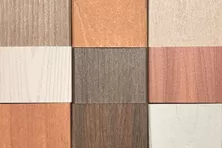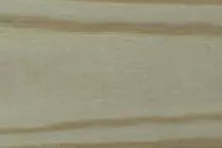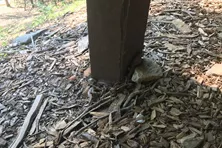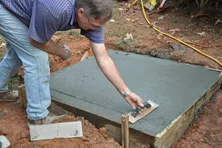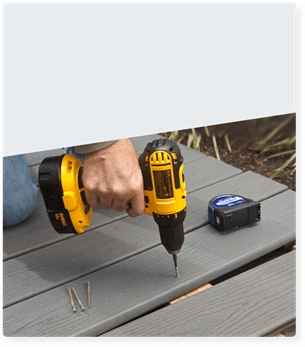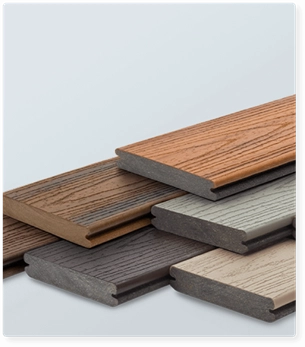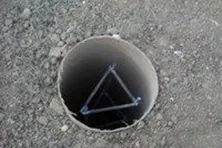Redwood Decking: Cost, Maintenace & Types of Redwood
Redwood is a remarkable deck material in almost every way. It is very stable, straight and its heartwood is naturally resistant to wood boring insects and weathering without the use a preservative chemicals. Its fragrant, earthy reddish brown heartwood gives it its name. If left unfinished, redwood will initially turn black and then slowly turn into a silver gray. Its high-stability makes it less likely to cup and warp than treated wood. It is prized for its low shrinkage rate, so splitting is minimized. Redwood fastens and machines well but can be brittle - you may need to pre-drill holes at the ends of boards to prevent splitting. Its milled or sanded surfaces accept paint and stain easily. It is recommended that you use a protective finish with a water repellant, mildewcide and ultraviolet inhibitor.
Grades Of Redwood Decking
There are over 30 grades of redwood, varying in appearance and durability. Redwood can be ordered in standard dimensional lumber sizes. Kiln-dried is more expensive, but is more stable. It may be helpful for tight jointery like for rail parts. There are two principle grades: Architectural and Garden Grade. Garden grade redwood should not be used for building decks because it contains sapwood.
Architectural – These grades contain only heartwood which exhibits all the best properties of the wood.
Clear Heart – This is a premium grade that offers knot-free surfaces. Because of its high expense, it is usually only used for rails and trim on decks. Clear Heart grade contains no grading defects. It is normally certified as Kiln-dried.
Select Heart – This is a step below Clear Heart and contains limited knots.
Construction Heart– Con Heart is less expensive than Clear Heart. A limited number of knots and some defects are present.
Deck Heart - Deck Heart has a similar appearance and use as Construction Heart, but is also graded for strength. Deck Heart is only available in 2x4 and 2x6.
Merchantable Heart – This grade is not recommended for decking. It is the cheapest heartwood grade and allows slightly larger knots than Con Heart grade and holes limited to the size of knots. You will find checks, some manufacturing flaws and some splits.
Garden – These grades may contain sapwood and are not recommended for decks. Garden grades are usually used for outdoor furniture, trellises, fences and planters.
Clear – Clear Garden exhibits the same general characteristics as Clear Heart except that sapwood is present. It is normally certified Kiln-dried. Garden grades should not be used for decks.
Construction Common – Exhibits the same general characteristics as Con Heart, but contains sapwood and heartwood. Garden grades should not be used for decks.
Trees And Environment
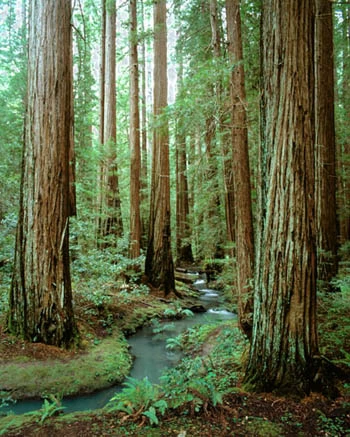
These trees are truly giants - averaging 8 feet in diameter and reaching as much as 20 feet in diameter, some are as tall as 375 feet. That is taller than the Statue of Liberty. Redwood trees are absolutely the largest living thing on Earth. Some old-growth redwood trees are over 1,000 years old. Native to the moist foggy coast of the Pacific Northwest, redwood trees are legendary for their size and the quality of softwood they provide. Because of past exploitation and abusive logging practices such as clear-cut forests, redwood building materials still carry the stigma of an environmental tragedy.
There are only 1.74 million acres of redwood forests left. Today, strict logging restrictions have been enacted to protect old-growth stands and specimen trees for scientific research. More than 95% of the remaining ancient redwood forests are protected from harvesting. There are over 250,000 acres of protected redwood forests in our state and national park system. Law now requires that companies owning more than 50,000 commercial acres of redwood forests are required to prepare a sustained yield plan. These plans must adhere for an equal balance of growth and harvest over a 100-year period to achieve sustainability. Many strides have been made to protect what is left. The Forest Stewardship Council (FSC) now independently certifies four out of every five acres of commercial redwood forest.
Capped Composite Decking
What is capped composite decking? It's a great option if you like the look of wood but not the maintenance. Learn about capped composite at Decks.com.
Gorilla Deck
Gorilla Deck Vinyl Decking is manufactured by Homeland Vinyl Products in Birmingham, AL.
Pressure Treated Wood: Types, Grading Standards & More
Wondering if pressure treated wood is right for your project? Learn more about the different types of pressure treated lumber as well as how long they last at Decks.com.
Cutting a Concrete Pad
Learn how to use a concrete saw to cut a hole in a patio slab to install a deck footing.
Can I reuse existing footings
Our inspector discusses the topic of reusing footings for a new deck.
Working With Concrete
Learn tips from the pros on how to mix and pour concrete for deck footings.
More Helpful Resources
Explore Articles by Topic

Footings
Information related to installing frost footings for decks

Framing
Learn structural framing methods

Decking
Learn about wood and composite decking materials

Stairs
An in-depth look at the complex issue of how to build stairs

Railings
How to install guardrails and handrails to meet IRC code

Features
An overview on water drainage, benches, planters and lights

Design
The basics of deck design

Planning
Learn about permits and working with contractors

Porches & Patios
Build a covered deck to enjoy all seasons

Ledger
Proper attachment techniques

Care
Maintain your deck to maintain your investment

Materials
An overview on water drainage, benches, planters and lights
Is Trex Decking Worth the Investment? Expert Insights and Reviews
Discover why Trex decking is worth the investment. Learn about its durability, low maintenance, eco-friendliness, and the long-term value it adds to your home.
TimberTech
TimberTech Decking is manufactured by Timbertech Limited in Wilmington, OH.
How many footings do I need?
Learn how to determine the number of footings and support posts you need for your deck when designing your deck frame.
Installing footings on a sloped yard
Our inspector explains how to install concrete deck footings on uneven ground.
Do I need to use rebar?
Our inspector discusses using steel rebar for deck footings.
Explore Articles by Topic

Footings
Information related to installing frost footings for decks

Framing
Learn structural framing methods

Decking
Learn about wood and composite decking materials

Stairs
An in-depth look at the complex issue of how to build stairs

Railings
How to install guardrails and handrails to meet IRC code

Features
An overview on water drainage, benches, planters and lights

Design
The basics of deck design

Planning
Learn about permits and working with contractors

Porches & Patios
Build a covered deck to enjoy all seasons

Ledger
Proper attachment techniques

Care
Maintain your deck to maintain your investment

Materials
An overview on water drainage, benches, planters and lights




